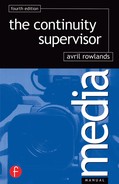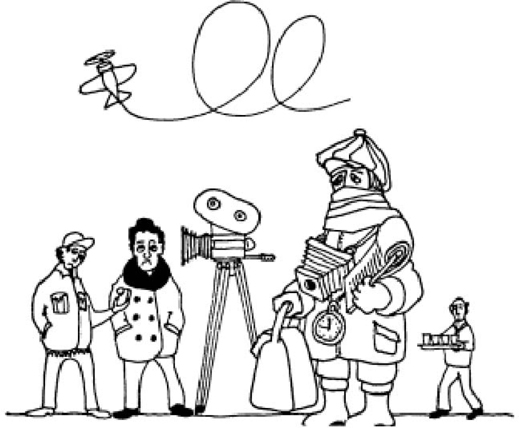There you stand, dressed in your oldest jeans and thickest sweater (unless you’re unbelievably lucky and start in fine weather): a stopwatch resting imposingly upon your bosom – maybe a Polaroid camera also – and a clipboard clutched as a lifeline in front of you. Pencils, ready sharpened, are secreted somewhere about your person; virginal continuity notes and unmarked pages of script lie neatly gathered under the clip on top of your clipboard, and securely tethered (in case of high winds) with a large rubber band. You may, being prepared for any eventualities, have a sheet of plastic covering the paperwork. In your capacious waterproof bag somewhere near your feet are spare copies of the script and the schedule, together with spare pens, pencils, adhesive tape, scissors – spares of everything, in fact, even down to the odd aspirin and safety pin. Your laptop is in your car, or it might be closer to hand in a nearby cowshed.
Around you stand the rest of the unit, all equally uncomfortable despite the ‘getting it together’ drinks at the director’s expense the previous evening. Everyone is bursting with the effort of being alert and appearing as impressive, busy and efficient as the others. One of the electricians cracks the first joke; the clapperloader comes up to you – or you go up to her – and pledges to keep you informed of changes of camera roll. You, in turn, promise to keep an eagle eye on the slate numbers, and if she marks up the wrong number, not hold her up to general ridicule – at least, not in the first week of shooting. She says, not trying to be original, ‘How about starting with Slate l?’ and you solemnly agree.
The DOP, gazing with a worried frown at the sky, asks the director: ‘What’s the first set-up?’ The director interrupts his agitated first AD, who is engaged in an earnest explanation of the lack of coffee/rolls/sausages, and rushes over to his DOP (who must be humoured). The first has a go at the third AD about the lack of coffee/rolls/sausages and the third sends a runner off on a search. You become unwittingly involved with the boom operator who, under the guise of telling you the sound roll number – which, believe it or not, is roll one – starts to get too familiar. This does nothing for your image on the first day of filming, so you leap off to the director and look concerned and interested while he explains his first shot to the camera crew.
Actors have now been called for, and appear in a flurry of makeup assistants with large powder puffs and dressers with large safety pins. The director and first are smothered in a round of complaints and embracings and the air is full of expressions in vogue with top artists. The rest of the unit stand round looking rather bored, except for the electrician who is looking round for likely talent.
Rehearsals commence, and you write down everything from the colour of the grass to the markings on the third rock on the left of frame. As rehearsals continue you neatly rub out what you first wrote as moves are changed, and then you rub out the second lot of notes as things change again.
Finally, all is ready for a take. The first calls for quiet, a call noisily echoed by the third and all the runners. The first then calls ‘turn over’, the sound recordist calls ‘speed’, the camera operator ‘mark it’, and the clapperloader, who’s been itching to do her bit with the clapperboard for the last minute, claps it and jumps out of the way. You, having already written the scene, the slate, the description of the shot, the set-up and the artists, are poised, one hand on the stopwatch, the other holding a razor sharp pencil.
The director calls ‘action’ and you’re away. He almost instantly calls ‘cut’ due to heavy artillery fire from the army practice range two miles off. The army wouldn’t play ball and stop their activities for the filming. The director casts a pained glance at the first – who couldn’t persuade the army; the first casts a pained glance at the third who hurries to find the runner. The runner, meanwhile has just arrived hotfot and panting with the coffee. The clapperloader painstakingly rubs out ‘1’ and writes ‘2’ on her board.
You write ‘NG, noise’ on your notes – the board is clapped, the army silenced, the gaffer electrician complains that the coffee/ rolls/sausages meant for the crew have been used to bribe the army into silence, and your first day doing the job of continuity has started.
But what, in fact, is the job and how does one do it?
Note
Although I wanted to avoid any sexual stereotypes in this book, as there is not a suitable pronoun referring equally to ‘he’ and ‘she’, I have referred to the person doing the job of continuity as ‘she’. I hope I will be forgiven for that or for any other apparent stereotypes. They are not intended.
Dressed sensibly and warmly and hung about with the trappings of the trade – clipboard, Polaroid camera, stopwatch, large canvas filming bag, etc. – you stand with eyes alert and pencil poised.

